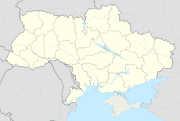Sambir
| Sambir | ||
| Самбір | ||

|
|
|
| Basic data | ||
|---|---|---|
| Oblast : | Lviv Oblast | |
| Rajon : | District-free city | |
| Height : | 295 m | |
| Area : | 13.00 km² | |
| Residents : | 36,218 (2004) | |
| Population density : | 2,786 inhabitants per km² | |
| Postcodes : | 81412 | |
| Area code : | +380 3236 | |
| Geographic location : | 49 ° 31 ' N , 23 ° 12' E | |
| KOATUU : | 4610900000 | |
| Administrative structure : | 1 city | |
| Mayor : | Yuri Hamar | |
| Address: | пл. Ринок 1 81400 м. Самбір |
|
| Statistical information | ||
|
|
||
Sambir (Ukrainian Самбір ; German Sombor , Polish Sambor , Russian Самбор / Sambor ) is a Ukrainian city with a little over 36,000 inhabitants in the Lviv Oblast .
location
Sambir is located in the Lower Carpathian Plain on the upper reaches of the Dniester River , 74 km southwest of the district capital Lviv , about 40 km east of the Ukrainian border with Poland. The next larger city is Drohobych , the city itself is the district center of the Sambir district of the same name , but administratively not part of it, but directly subordinated to the oblast administration.
history
Sambor was first mentioned in 1199 as part of the principality of Halych-Volhynia .
After the attack by the Golden Horde in 1241, part of the population settled in the current location and founded the place Novyj Sambor ( New Sambor ). The original place was named Staryj Sambor ( Old Sambor ) and still exists today.
In 1340 Sambor came to the Kingdom of Poland , in 1366 it was incorporated into the newly established Ruthenian Voivodeship , as the seat of a powiat Sambor in the Przemyśler Land ( Ziemia Przemyśka ).
In 1387 it came under Hungarian rule for a short time .
Under King Władysław II Jagiełło , Sambor received Magdeburg town charter in 1390 . In the period that followed, numerous German and Jewish residents came to the city.
The city became famous for its salt mines . It was a center of salt production as early as the 14th century .
1569–1772 she was part of the Ziemia Lwowska ( Lviv country ) of the aristocratic republic of Poland-Lithuania .
Between 1772 and the end of the First World War it was located in the Austrian crown land Kingdom of Galicia and Lodomeria , here it was designated as the seat of the Sambor District Commission in 1850 , and a district court was added in 1867, both of which existed until 1918.
After the First World War, the city was briefly part of the West Ukrainian People's Republic , but after the non-recognition of the Curzon Line by Poland it belonged to the Polish state until 1939 and was here in the Lviv Voivodeship from 1921 .
During the Second World War , Soviet troops initially occupied the city on the basis of the German-Soviet non-aggression pact , until the city was incorporated into the General Government after the German invasion of the Soviet Union . At the end of the war, they were incorporated into the Ukrainian Union Republic of the USSR , which became a sovereign state in 1991.
Attractions
- Castle ruins (16th century)
- Church of St. John the Baptist (1530–1568)
- St. Bernard Monastery (17th century)
- Brigitten Monastery (17th century)
- Town hall (17th - 19th centuries)
- Church of Saint Valentina and Our Lady of Miracles of Sambir (18th century)
- Town houses on the market (17th - 20th centuries)
economy
As early as the 14th century, the city was a center of salt production . The wood industry is of economic importance .
Sons and daughters
- Georg Franz Kolschitzky (Jerzy Franciszek Kulczycki, 1640–1694), Polish-Austrian businessman, interpreter and spy was born in the neighboring village of Kultschyzi .
- Andrij Tschaikowskyj (1857–1935), Ukrainian writer and politician
- Władysław Abraham (1860–1941), Polish historian
- Salka Viertel (Salomea Steuermann, 1889–1978), Austrian actress and screenwriter
- Eduard Steuermann (1892–1964), Austrian-American pianist and composer
- Zygmunt Steuermann (1899 – unknown), Polish national soccer player and victim of the Holocaust
- Zacharias Dische (1895–1988), American biochemist
- Tadeusz Pankiewicz (1908–1993), Polish pharmacist and Righteous Among the Nations
- Artur Sandauer (1913–1989), Polish literary critic
- Roman Bobak (* 1990), Ukrainian football player
Town twinning
Sambir has a partnership with Oświęcim in Poland.






